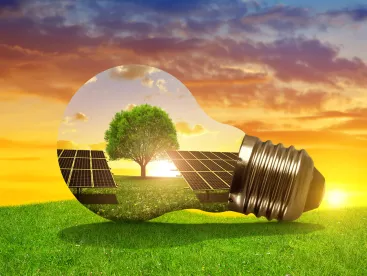Key Takeaways
-
Legislative Action: On April 12, Virginia Governor Ralph Northam signed the Clean Economy Act (Act), establishing significant new requirements for renewable energy, energy storage, and energy efficiency.
-
Key Issues for Regulated Entities:
-
The Act establishes the Commonwealth’s first-ever mandatory Renewable Portfolio Standard (RPS), requiring Dominion Energy Virginia (Dominion) and Appalachian Power[1] to produce 100% carbon-free power by 2045 and 2050, respectively.
-
Nearly all coal-fired power plants must close by the end of 2024.
-
The Act will trigger a suite of new regulations at the state level. The State Air Pollution Control Board is required to adopt regulations to reduce carbon dioxide emissions from certain electric generating units, which may include an auction program for emissions allowances and emissions trading. The State Corporation Commission (Commission) is also required to develop its own determination regarding the social cost of carbon, and may issue new regulations describing and implementing that determination.
-
Virginia’s cap on third-party power purchase agreements for renewable energy will increase significantly.
-
Most biomass plants will be phased out under the Act.
-
-
Timeline: Under the Act’s mandatory RPS, Dominion and Appalachian Power must generate specified amounts of electricity from renewable energy sources starting in 2021, with the amount increasing each year thereafter through 2050. The regulations to reduce carbon dioxide emissions cannot be adopted until July 1, 2024, and social cost of carbon rules may be adopted any time after July 1, 2020.
Mandatory RPS
The Act replaces Virginia’s existing voluntary RPS with a mandatory RPS Program. Under the revised RPS, Dominion and Appalachian Power Company must generate specified amounts of “RPS eligible sources” starting in 2021, with separate tracks for each utility. Dominion must achieve 14% in 2021, with the requirements increasing to 41% by 2030, and 100% by 2045. Appalachian Power must meet a 6% standard in 2021, with the requirements incrementally increasing to 30% by 2030, and 100% by 2050. To achieve these goals, the Act requires that nearly all coal-fired power plants be closed by December 31, 2024.
“RPS eligible sources” include electricity generated in Virginia through any wind or solar generating resources and certain types of hydroelectric, waste-to-energy, landfill gas-fired, and co-fired biomass generating sources. Utilities may not rely on nuclear energy or renewable thermal energy to meet the RPS requirements.
Dominion’s updated long-term integrated resource plan now reflects these changes, showing significant increases in solar, wind, and energy storage capacity for the state. Dominion also recently issued a request for proposals for power purchases up to 1 GW of solar and onshore wind and up to 250 MW of energy storage. Eligible projects must come online by the end of 2023.
Biomass
The Act substantially curtails biomass energy production in Virginia by requiring permanent retirement of all existing stand-alone biomass plants by 2028. Biomass is not included in the Act’s definition of “RPS eligible sources,” and only certain biomass production is eligible under the RPS. Specifically, the RPS only provides credit for those biomass facilities located in Virginia that provide the majority of their electricity to co-located manufacturing plants, sending no more than 10% back to the grid. Even for those facilities, the number of credits that may be sold for biomass electricity is capped at the amount produced in 2019.
This approach to biomass differs significantly from EPA’s planned proposal to classify biogenic carbon dioxide emissions from power plants as carbon neutral (as summarized in our prior alert). EPA’s proposed rule is pending review by the White House Office of Management and Budget.
RGGI
The Act establishes a carbon dioxide cap-and-trade program that will allow Virginia to join the Regional Greenhouse Gas Initiative (RGGI), making it the first southern state to do so. A separate Virginia law, the Clean Energy and Community Flood Preparedness Act, requires (among other measures) the Virginia Department of Environmental Quality (DEQ) to adopt specific provisions required for the state to comply with the RGGI model rules. Those provisions must be incorporated immediately into DEQ’s existing regulations, and do not require any further regulatory review under the state Administrative Procedure Act.
Social Cost of Carbon
The Act requires the Commission to determine the social cost of carbon, and authorizes the Commission to adopt new rules in order to do so. Any such new rules must consider the “best available science and technology,” including the Obama Administration’s August 2016 analysis and estimates. All utilities will be required to include the social cost of carbon in any application to construct a new generating facility, and the Commission must consider those costs in evaluating applications.
Additional Provisions
-
Energy storage: By 2035, utilities must contract for minimum amounts of energy storage capacity, subject to regulations forthcoming from the Commission. At least 35% of utilities’ energy storage facilities must be developed or owned by non-utility partners.
-
Energy efficiency: Utilities are required to achieve incremental annual energy efficiency savings, starting in 2022 at 0.5% for Appalachian Power and 1.25% for Dominion, and increasing to 2% and 5% by 2025, respectively.
-
Offshore wind: Dominion will be required to develop up to 5,200 MW of offshore wind projects by 2035.
-
Power purchase agreements: The Act dramatically increases the limits on third-party power purchase agreements, allowing 1,040 MW in total, as compared to 57 MW under the prior program.
-
Environmental justice: The Act caps monthly electricity payments of low-income residents based on income; requires utilities to consider how to inform low-income customers of cost savings opportunities through solar energy; and requires consideration of any benefits and burdens arising from the Act on historically economically disadvantaged communities.
-
Net metering: The Act increases the Commonwealth’s previous cap on net metering from 1% to 6%, encouraging an expansion of rooftop solar usage in Virginia.
[1] The Act applies to “Phase I” and “Phase II” utilities, as defined in Virginia’s electric utility regulations. In practice, those terms exclusively apply to Virginia’s two largest electric utilities, Dominion Energy Virginia (Phase II) and Appalachian Power Company (Phase I).







 />i
/>i
